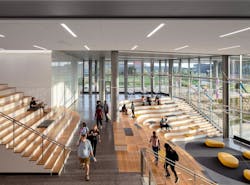Sustainable Design Continues to Ascend in 2019
Sustainability has become a key way in which buildings are both created and operated. It refers not only to the structure, but how that facility is structured. Certifications for green building like LEED and WELL are on the rise—57% of building owners plan to make the majority of their projects green by 2021, according to the USGBC’s World Green Building Trends SmartMarket Report.
In addition, two-thirds of the survey participants reported that using a rating system such as LEED allows them to create a better-performing building.
Businesses benefit when buildings are built better—operating costs decrease, there’s shorter payback periods and asset values can increase. It’s important to note that healthier indoor environments are just as much of a motivator for sustainable building, too.
As Lynn Brotman, associate principal of Svigals + Partners, points out: “The basic principles of green building are well-known, but it is essential to consider the occupant’s full experience of the space while specifying products, materials and systems.”
Exteriors, interiors and the products that fill the spaces are all finding ways to be more sustainable—from incorporating living plants and increasing natural daylight to utilizing zero-VOC materials and reusing original structures, companies are rapidly reassessing the materials and processes behind their work.
Updated 1920s-era industrial structure at Boston Seaport
Developer The Davis Companies updated a 1920s-era industrial structure at the Boston Seaport for maker companies and businesses. Throughout, touches of the outdoors were brought in, including at the café. It combines custom wood walls and furniture with floor-to-ceiling glass facing the water.
[Related: Glass Buildings Reflect Many Benefits]
These elements establish a connection to the outdoors and the natural world, and allow for natural daylight to come in. This contributes to a healthy interior space while reducing electricity consumption and the associated carbon output.
915 Wilshire, downtown Los Angeles
Sustainability was an important factor to architecture and design firm HLW when renovating the lobby and other common spaces at 915 Wilshire, a 22-story office tower in downtown Los Angeles.
“Environmentally friendly and natural materials were prioritized for all spaces in our project,” says Louise Sharp, principal for HLW’s LA office.
BUILDINGS Podcast
LEED Zero: New Designation for Net Zero
Learn more about this designation, including the requirements behind it and how it can benefit your building. Listen now >>
Solid wood grills on the main lobby’s ceiling and walls were sourced from Forest Stewardship Council-certified forests. Products that are FSC-certified come from a forest and supply chain that is managed responsibly.
Northern Kentucky University’s Founders Hall
Northern Kentucky University’s Founders Hall, originally built in 1974, was recently renovated by CO Architects to be joined with the new Health Innovation Center. The goal was to modernize faculty offices, conference rooms, classrooms and research labs.
The building is targeting LEED Gold certification, with a 40% energy reduction over the baseline code through the use of chilled beams, geothermal wells and demand controlled ventilation.
“Raingardens will filter and collect storm water and be used as a teaching tool to demonstrate the importance of recharging natural water aquifers,” says CO Architects principal James Simeo.
Renovated Office Building 7 Sylvan Way in Parsippany, NJ
The design team at office building 7 Sylvan Way in Parsippany, NJ, renovated a 4,400-square-foot atrium and added an adjacent 1200-square-foot café amenity with a kitchen. The team retained as many existing elements as possible, such as rose-colored marble on the walls, while selecting new design elements and finishes to enliven the space.
All specifications include attention to energy efficiency and environmental sustainability. The renovation includes the use of LED lighting fixtures, no-VOC paints, ENERGY STAR-rated appliances and faux zebra wood composite veneer composed of reconstituted sawdust.
NextCorps is the New Downtown Rochester, NY
NextCorps is the new downtown Rochester, NY, headquarters and collaborative workplace for the state and federally designated business incubator of the same name. Local and sustainable touches can be found throughout the former department store space.
The restored historic space features original moldings and walk-through buffet—a relic of the room’s history as a restaurant during the department store’s heyday. Task seating throughout NextCorps is manufactured by local fabricator Seating Inc.
Custom-made conference tables by local furniture manufacturer Staach and a one-of-a-kind 55-foot wall mural by local artist Nate Hoge tap into the resources and talent of the local community.
Fir Tree Partners, NY
Kostow Greenwood Architects has been working with Fir Tree Partners in New York since 1999. The private investment firm recently needed an office redesign to accommodate their growing organization, and again Kostow Greenwood Architects took the helm.
The renovated space now has more conference rooms, quiet and wellness rooms, and a café with a wood-slated ceiling. The wood veneers come from reclaimed water towers; all architectural materials and furniture were also specified for low-VOC; and window shades are provided to manage daylight and heat loads.
St. Louis Arc’s Community Center
The St. Louis Arc’s Community Center serves the organization’s growing population of aging adults with intellectual and developmental disabilities to live a better and more meaningful life.
[See their wayfinding solutions: How to Navigate a Wayfinding Redesign]
Sustainable solutions were built into the redesign. Low-VOC materials include adhesives, finishes, paints and primers. The lighting throughout is all LED. Surfaces, particularly in the kitchenette, resist staining and scratching, and are built to accommodate community members with varying mobility issues, including those in wheelchairs.
Offices for Union Square Ventures
The offices for Union Square Ventures, a venture capital firm whose clients include Soundcloud, Kickstarter and Stripe, feature a mix of natural and manufactured materials. The design “merges glass, natural woods and cool metals with the building’s industrial elements—polished concrete floors and exposed sprinkler heads.
“The result is a crisp, streamlined interior mood,” explains Mary Burnham, partner of Murphy Burnham & Buttrick Architects.
Furnishings are a mix of contemporary pieces and midcentury modern icons; upholstered pieces, graphics and contemporary art provide punches of color and convey an attitude appropriate to the agile workplace practices of a leading venture capital firm.
Daylight streams into the Union Square Ventures office through tall windows that provide plentiful natural illumination. Glass-walled private offices also receive abundant daylight from their position along the north wall.
Office of Sightbox
Indoor plants are amply provided in the space to bring a little nature indoors, explain Allyson Strowbridge, owner and principal of ctrl+shift+space, and Jamie Willemse, owner of Studio 7 Design.
The Portland office space makes extensive use of biophilic concepts to create a welcoming workspace.
Preserved moss panels and living plants surround the individual work zones in the customer success area and an adjacent collaboration space. Center columns are wrapped in birch bark wallpaper.
The customer success team’s workspaces also feature ceiling baffles made from 99% recycled materials to account for the acoustic requirements of the phone-based services the team provides.
Stantec Breakroom in Portland, OR
The 1,050-square-foot breakroom at Stantec’s Portland, OR, office features a living wall.
[Trending: Living Walls Put the ‘Green’ in Greenbuild]
Plants are interspersed along a natural 34-foot-long wall made of western red cedar from Oregon, and the expanse of windows provides plenty of daylight and views of the city. The breakroom also has a 15-foot conversation island for casual meetings.
Yale-New Haven Health System Business Office
The new office for the Yale-New Haven Health System’s business service team, the Systems Business Office, introduces plenty of daylight by using the existing light monitors and skylights in the former high school gym.
The abundant natural light reduces the electricity consumption of the office and makes the about 280 people working in the space healthier and more productive, explains Lynn Brotman, associate principal of Svigals + Partners, the architecture firm that designed the space.
“The design also includes zero-VOC finish materials and paints, as well as creative uses of Yale-New Haven Health’s standards for workplaces,” Brotman adds.
A new mezzanine level at the street and main entrance level wraps around the Yale-New Haven Health System’s Systems Business Office. The mezzanine adds 3,500 square feet of expansion space. The walls boast a collage of colorful acoustical panels that create visual interest while reducing noise.
“Embrace the limitations. They help define the parameters of the space,” Brotman advises for renovation projects. “The best ways to increase the perceived size of the space are achieved by thinking volumetrically, i.e. non-traditional ceilings, coordination and integration of light sources and holistic design.”
North of Columbia City (NOCO) Flats
The North of Columbia City (NOCO) Flats is Dwell Development’s first venture away from building single-family and townhomes.
The project is one of the few apartment buildings in Seattle to use next-generation solar thermal technology for hot water heating, a cost-effective and eco-friendly way to generate hot water for residents.
NOCO Flats is the first apartment building since 2012 to achieve 5-star Built Green certification, which is a holistic green home certification program from the Master Builders Association of King and Snohomish counties in Washington.
Studio Matthews Exhibit at Bill & Melinda Gates Foundation Discovery Center
Studio Matthews wanted its Design With the 90% exhibition, on display at the Bill & Melinda Gates Foundation Discovery Center through May 2019, to reflect the content of its 26 featured projects from around the world.
To that end, the exhibition, fabricated by Pacific Studio in Seattle, is entirely comprised of sustainable, recyclable materials that are still robust enough to last during its nine months on display.
Vitrine bases are made from industrial cardboard Sonitubes. Project displays are made of Eco Board kraft panels with text printed directly on the surface to avoid using plastic, and the oversize black and white hanging images for the exhibition are printed on Tyvek, a material typically used for building envelopes and insulation that is both strong and resistant to tearing.
Proof for Green Buildings
The projects featured above prove that “going green” doesn’t have to equate to sacrificing quality work or a pleasing aesthetic. As Kate Macaulay, NCIDQ, project manager for The Architectural Team Inc., notes: “Even within a renovated space, there are always ways to encourage sustainability and create a healthy interior environment.”
Two handpicked articles to read next:
About the Author

Adrian Schley
Staff Writer
Adrian Schley has been writing for interiors+sources magazine since March of 2018 and creates content for the BUILDINGS team. She earned her BA in journalism at the University of Iowa, where she also studied English.
